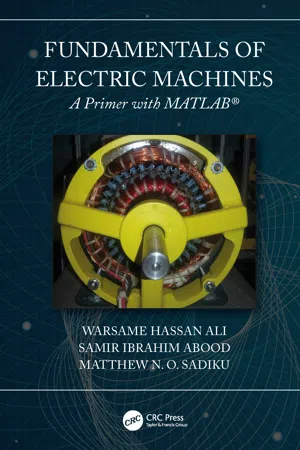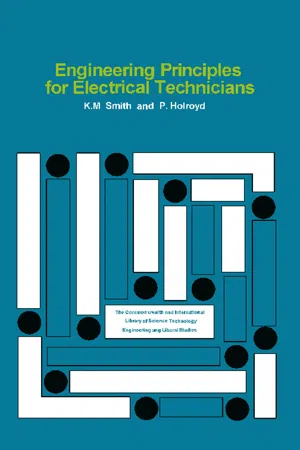Physics
Magnetic Flux
Magnetic flux is a measure of the total magnetic field passing through a given area. It is a fundamental concept in electromagnetism and is defined as the product of the magnetic field strength and the area it penetrates, with the angle between the field and the area taken into account. Magnetic flux plays a crucial role in understanding magnetic phenomena and electromagnetic induction.
Written by Perlego with AI-assistance
Related key terms
Related key terms
1 of 4
Related key terms
1 of 3
6 Key excerpts on "Magnetic Flux"
- eBook - ePub
- Michael M. Mansfield, Colm O'Sullivan(Authors)
- 2020(Publication Date)
- Wiley(Publisher)
Chapter 16 .As before, the total flux from a source is also used as a measure of the strength of the source. Thus the flux concept is carried over to the case of magnetic fields simply by defining the total Magnetic Flux(ΦM )from a pole as being equal to the magnetic pole strength, that isEven when the magnet is not long and thin (such as in Figure 18.2 (a)), the pole strength can be defined as the total flux emanating from the N pole end (or sinking at the S pole).The intensity at some point in a magnetic field can be measured in terms of the Magnetic Flux per unit area at that point. Thus a vector quantity, called the Magnetic Flux density is defined bywhereΔΦMis the Magnetic Flux through an areaΔAwhich is perpendicular to the field lines through the point and is a unit vector tangential to the field lines, that is perpendicular to ΔA, as illustrated in Figure 18.18 . The SI unit of Magnetic Flux density isWb m−2, called the tesla (after Nikola Tesla 1856–1943), that is,1 tesla = 1 Wb m−2 = 1 T.1Figure 18.18ΔΦMis the Magnetic Flux through the areaΔA. The Magnetic Flux density B is directed perpendicularly to the areaΔA, that is, tangentially to the local magnetic field line.From the definitions presented above, both the Magnetic Flux density B and the magnetic field strength H at a point in a non‐conducting medium are directed along the tangent to the local magnetic field line through that point ( in Figure 18.18 ). Thus B is parallel to H, that isThe value ofμdepends on the nature of the medium in which the currents and/or magnetic poles which give rise to the magnetic field and the field itself are immersed. The quantityμ, therefore, is a property of the medium and is called the permeability of the medium. The distinction between B and H will become clearer in Section 19.9 - eBook - ePub
- W. Bolton(Author)
- 2015(Publication Date)
- Routledge(Publisher)
Chapter 14 Magnetic Flux14.1 Introduction
This chapter follows on from the discussion of magnetism in Chapter 10 and considers in more detail electromagnetic induction. Magnetic lines of force can be thought of as lines along which something flows, this being termed flux . When the Magnetic Flux linked by a coil changes then an e.m.f. is induced.We also look at the effect of the materials through which lines of Magnetic Flux pass. This is important since most devices employing magnetism involve the use of materials such as iron or steel in their construction. When any material is placed in a magnetic field, the extent to which the magnetic field permeates the medium when compared with what would happen in a vacuum is known as the relative permeability. For a material termed ferromagnetic, such as iron, there is a tendency for the lines of Magnetic Flux to crowd through it and it has a high relative permeability (Figure 14.1(a) ). An important consequence of this high permeability of iron is that an object surrounded by iron is almost completely screened from external magnetic fields as the Magnetic Flux lines crowd through the iron (Figure 14.1(b) ).Finally in this chapter we look at the forces experienced by current-carrying conductors when in magnetic fields, this being the basic principle behind d.c. motors.Figure 14.1 (a) A piece of iron in a magnetic field, (b) screening14.2 Electromagnetic induction
We can represent Faraday’s law and Lenz’s law for electromagnetic induction (see Chapter 10 ) as:induced e.m.f. e ∝ – (rate of change of flux Φ with time t )The minus sign indicates that the induced e.m.f. is in such a direction as to oppose the change producing it. We can put the constant of proportionality as 1 and write rate of change of flux as dΦ /dt :The unit of flux is the weber (Wb). If the flux linked changes by 1 Wb/s then the induced e.m.f. is 1 V. For a coil with N turns, each turn will produce an induced e.m.f. and so the total e.m.f. will be the sum of those due to each turn and thus: - No longer available |Learn more
- Robert A. Pelcovits, Joshua Farkas(Authors)
- 2023(Publication Date)
- Barrons Educational Services(Publisher)
A to point in one of the two directions perpendicular to the area (recall that you must be consistent about this choice).4.To find the entire flux, integrate the expression for dΦBover limits determined by the geometry of the situation. Always integrate from the lower limit to the upper limit. Use the same choice for the direction of dA across the entire surface.Flux Through a Coil
The flux through a coil is the sum of the fluxes through every loop of wire so that the flux through the entire coil is equal to the number of loops multiplied by the flux through each loop. Mathematically,The SI unit for flux is the Weber, defined as 1 Wb = 1 T ⋅ m2 .Faraday’s Law
TIP Note that the Magnetic Flux must change with time to induce an EMF.Faraday’s law (scalar form)In words, a changing Magnetic Flux through a loop of wire induces an electromotive force (EMF, denoted by ). We will use this equation to calculate the magnitude of induced EMFs, and later in the chapter we will use Lenz’s law to figure out the direction of induced EMFs. (Recall that the term “EMF” means essentially the same thing as “voltage.”)Before we jump into applying Faraday’s law, let’s take a moment to gain some further insight by rewriting Faraday’s law for a uniform B field aswhere θ is the angle between the field and the area vector.What this reveals is that an EMF can be induced by changing the area, the magnetic field, the angle θ, or some combination of these variables. The AP exam very often asks about one of the first three of these situations, all of which are illustrated in examples below.Using Faraday’s Law
The situations where we use Faraday’s law are much more varied than the situations where we use Gauss’s or Ampere’s law, so there isn’t much of a general approach other than the guidelines presented for calculating flux. However, we will attempt to familiarize you with all of the scenarios that are likely to appear on the exam. - eBook - ePub
Functional Molecular Materials
An Introductory Textbook
- Matteo Atzori, Flavia Artizzu(Authors)
- 2018(Publication Date)
- Jenny Stanford Publishing(Publisher)
This is one of the most ancient scientific subjects and one of the most difficult to understand. Closely connected with magnetism is magnetochemistry. This is a field of chemical physics that deals with magnetic measurements performed on chemical compounds, both molecular and atom based, as a tool to get information on their chemical structure. Finally molecular magnetism can be defined as a relatively new field of physics born to describe and understand the magnetic properties shown by magnetic molecular materials. 1 A deep knowledge of these three disciplines allows one to design new materials with expected magnetic properties and to understand their magnetic behaviors. The following sections describe their fundamental principles, with particular attention to those classes of materials that will be the theme of Chapter 3. 2.1.1 Magnetic Field One of the fundamental principles in magnetism is the concept of “magnetic field.” A magnetic field is produced whenever there is a charge in motion. This can be associated with an electrical current flowing in a conductor as was first discovered in 1819 by Oersted, or it can be generated by a permanent magnet. In the latter case there is no conventional electric current, but the orbital and spin motions of the electrons forming the permanent magnet lead to a magnetization within the material and to magnetic field generation. When a magnetic field is generated in a certain volume of space, an energy gradient is established and a force is produced - eBook - ePub
Fundamentals of Electric Machines: A Primer with MATLAB
A Primer with MATLAB
- Warsame Hassan Ali, Matthew N. O. Sadiku, Samir Abood(Authors)
- 2019(Publication Date)
- CRC Press(Publisher)
8 field line) and given by the formula:FIGURE 1.9Two conductors carrying current. (http://WWW.phys4arab.net ).B = ϕ /A,(1.1) where A is the area of the cross-section (m2 ) where the density of the lines is to be found.Example 1.1 What is the density of the flux in the area of the number of lines passing through a rectangle of 40 × 250 cm, which are 12 million lines?1.9 Magnetic Field and Its PolaritySolutionWe convert the number of lines to Weber (the unit of the flux), where the Weber equals one hundred million lines:Φ = 12 ×The area of the passage through which the lines of forces are:10 6/10 8= 0.12 W b .So, the density of the flux is equal:A = 250 × 40 × 10 -4= 1m 2B = 0 .12/1 = 0.12 Wb/m 2.In 1820, Oersted discovered the relationship between magnetism and electrical when he showed that the current carrying wire generates its own magnetic field. When the wire forms a solenoid and a current is passed, the sphere of single coil rings accumulates to generate a strong magnetic field within the axis of the coil, as shown in Figure 1.10 . In the case of putting a rod of iron or plastic material of ferromagnetic within this coil as shown in Figure 1.11 , the magnetic field will increase several times. This arrangement is very important and has many uses and is called electromagnetic - eBook - ePub
Engineering Principles for Electrical Technicians
The Commonwealth and International Library: Electrical Engineering Division
- K. M. Smith, P. Holroyd, N. Hiller(Authors)
- 2013(Publication Date)
- Pergamon(Publisher)
Fig. 13.4(b) ) the voltmeter will indicate a deflection in the opposite direction to previously and the reversed current flow will make the left-hand end of the coil a south pole. The force set up tries to prevent the magnet from leaving the coil.It can be shown that the faster the magnet is moved, the bigger the deflection on the voltmeter, and for a given speed a stronger magnet will produce a bigger deflection than a weak one. In other words, a larger e.m.f. will be induced in the coil which in turn will cause a greater current.13.9 E.M.F. induced in a coil
During the movement of the magnet, the Magnetic Flux is said to be changing its linkage with the coil. Faraday’s law of induction states that the average e.m.f. induced in the coil depends upon the average rate of change of flux linkages.If N is the number of turns on the coil and Φ the flux linking the coil, N Φ is called the flux linkages. The average induced e.m.f. iswhere t is the time in seconds for the change of flux linkages and Φ is the flux in webers (pronounced “vayber”).13.10 Unit of Magnetic Flux
In the m.k.s. system of units, the weber (Wb) is the unit of flux. It is defined as follows: if a flux of 1 weber linking a coil of one turn were uniformly decreased to zero in one second, the e.m.f. induced in the coil would be 1 volt.andEXAMPLE A flux of 200 mWb, when linking a coil of 100 turns, is reduced uniformly to zero in 0·05 sec. What is the value of the e.m.f. induced in the coil during this period?13.11 Unit of Magnetic Flux density
Suppose that a Magnetic Flux were uniformly distributed over an area and that it was at right angles to this area. The density of the flux would be expressed as the amount of flux per unit area. In the m.k.s. system of units, the unit of area is the square metre and soIn the SI system the unit is the tesla (T).EXAMPLEIf a flux of 1 mWb is at right angles to an area of 20 cm2 , what is the flux density?13.12 Principle of the transformer
A simple transformer has two windings wound round a common magnetic core. If a current in one winding, called the primary, is continually changing its magnitude, there will be a continually changing Magnetic Flux. This flux will change its linkage with the other winding, called the secondary, and an e.m.f. will be induced in it. These conditions exist when the primary winding carries an alternating current. An alternating e.m.f. is induced in the secondary.
Index pages curate the most relevant extracts from our library of academic textbooks. They’ve been created using an in-house natural language model (NLM), each adding context and meaning to key research topics.
Explore more topic indexes
Explore more topic indexes
1 of 6
Explore more topic indexes
1 of 4





